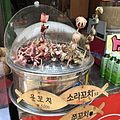Skewer
Skewer is a long, thin, pointed rod used for holding pieces of food together during cooking. The term is derived from the Middle English word skew, meaning "to pierce or penetrate". Skewers are typically made from metal or wood, and are a common tool in various cooking methods, including grilling, roasting, and broiling.
History[edit]
The use of skewers in cooking dates back to prehistoric times, when early humans would use sharpened sticks to cook food over an open fire. This method of cooking was prevalent in many ancient cultures, including the Ancient Greeks, who were known for their love of skewered meats, known as souvlaki.
Types of Skewers[edit]
There are several types of skewers used in different culinary traditions around the world. Some of the most common include:
- Metal Skewers: These are durable and reusable, often used in grilling and broiling. They are typically made from stainless steel or other heat-resistant metals.
- Wooden Skewers: These are disposable and often used for smaller pieces of food or for serving. They must be soaked in water before use to prevent them from burning.
- Bamboo Skewers: A type of wooden skewer, bamboo skewers are popular in Asian cuisines, particularly for making satay.
- Flat Skewers: These have a flat shape that prevents food from spinning around when it's being turned. They are often used for grilling kebabs.
Uses[edit]
Skewers are used in a variety of cooking methods and dishes. They are most commonly used in grilling, where they hold pieces of meat, vegetables, or seafood together while they cook. Skewers are also used in baking, particularly for testing the doneness of cakes and breads. In addition, skewers are used in the presentation of food, particularly in dishes like kebabs, satay, and souvlaki.
Safety[edit]
When using skewers, it's important to handle them safely to prevent injury. This includes using heat-resistant gloves when handling hot skewers, and ensuring that wooden skewers are properly soaked to prevent them from catching fire.
-
Wooden skewers
-
Akrotiri terracotta firedogs with zoomorphic finials
-
Chenjeh
-
Seafood skewers
-
Skewered food at Shida Night Market in Taipei
-
Brochette de dinde sur une assiette près de Jijel
Ad. Transform your life with W8MD's Budget GLP-1 injections from $75


W8MD offers a medical weight loss program to lose weight in Philadelphia. Our physician-supervised medical weight loss provides:
- Weight loss injections in NYC (generic and brand names):
- Zepbound / Mounjaro, Wegovy / Ozempic, Saxenda
- Most insurances accepted or discounted self-pay rates. We will obtain insurance prior authorizations if needed.
- Generic GLP1 weight loss injections from $75 for the starting dose.
- Also offer prescription weight loss medications including Phentermine, Qsymia, Diethylpropion, Contrave etc.
NYC weight loss doctor appointmentsNYC weight loss doctor appointments
Start your NYC weight loss journey today at our NYC medical weight loss and Philadelphia medical weight loss clinics.
- Call 718-946-5500 to lose weight in NYC or for medical weight loss in Philadelphia 215-676-2334.
- Tags:NYC medical weight loss, Philadelphia lose weight Zepbound NYC, Budget GLP1 weight loss injections, Wegovy Philadelphia, Wegovy NYC, Philadelphia medical weight loss, Brookly weight loss and Wegovy NYC
|
WikiMD's Wellness Encyclopedia |
| Let Food Be Thy Medicine Medicine Thy Food - Hippocrates |
Medical Disclaimer: WikiMD is not a substitute for professional medical advice. The information on WikiMD is provided as an information resource only, may be incorrect, outdated or misleading, and is not to be used or relied on for any diagnostic or treatment purposes. Please consult your health care provider before making any healthcare decisions or for guidance about a specific medical condition. WikiMD expressly disclaims responsibility, and shall have no liability, for any damages, loss, injury, or liability whatsoever suffered as a result of your reliance on the information contained in this site. By visiting this site you agree to the foregoing terms and conditions, which may from time to time be changed or supplemented by WikiMD. If you do not agree to the foregoing terms and conditions, you should not enter or use this site. See full disclaimer.
Credits:Most images are courtesy of Wikimedia commons, and templates, categories Wikipedia, licensed under CC BY SA or similar.
Translate this page: - East Asian
中文,
日本,
한국어,
South Asian
हिन्दी,
தமிழ்,
తెలుగు,
Urdu,
ಕನ್ನಡ,
Southeast Asian
Indonesian,
Vietnamese,
Thai,
မြန်မာဘာသာ,
বাংলা
European
español,
Deutsch,
français,
Greek,
português do Brasil,
polski,
română,
русский,
Nederlands,
norsk,
svenska,
suomi,
Italian
Middle Eastern & African
عربى,
Turkish,
Persian,
Hebrew,
Afrikaans,
isiZulu,
Kiswahili,
Other
Bulgarian,
Hungarian,
Czech,
Swedish,
മലയാളം,
मराठी,
ਪੰਜਾਬੀ,
ગુજરાતી,
Portuguese,
Ukrainian






